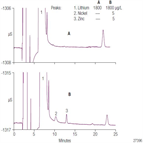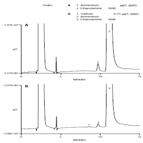Find methods for your needs
Refine by Feature
Displaying 1-3 of 3 results for Tag: IonPac SCS 1
AN250: Determination of Trace Nickel and Zinc in Borated Power Plant Waters Containing Lithium Hydroxide Using Nonsuppressed Conductivity Detection
Instrument Type: ICBoron as boric acid is used to control the nuclear reaction in pressurized water reactors (PWR) because of its strong neutron-absorbing characteristics. In addition, lithium is added to adjust the pH and zinc is added to suppress cobalt (58Co, 60Co) activity. Dissolved Ni in these solutions can be indicator of stress corrosion. To minimize corrosion, Ni and Zn monitoring is needed. Here µg/L of Ni and Zn in borated lithium water samples are determined on IonPac SCS-1 column and detected by non-suppressed conductivity. We recommend AN277 if sub-ppb detection is needed.
AN286: Determination of Trace Copper, Nickel, and Zinc in Boiling Water Reactors Using Nonsuppressed Conductivity Detection
Instrument Type: ICThis work describes the determination of trace concentrations of copper, nickel, and zinc in a boiling water reactor (BWR) matrix (i.e., deionized water) by cation-exchange chromatography using a 2 mm Thermo Scientific Dionex IonPac SCS 1 column and nonsuppressed conductivity detection. A Thermo Scientific Dionex Ultralow Pressure Trace Cation Concentrator (TCC-ULP1) column is used to concentrate 8 mL of sample, which enables detection limits of <0.2 μg/L for copper, nickel, and zinc.
AN158: Determination of Trace Sodium and Transition Metals in Power Industry Samples by Ion Chromatography with Nonsuppressed Conductivity Detection
Instrument Type: ICThis application compares suppressed to nonsuppressed conductivity detection for the determination of sub-ppb concentrations of sodium in simulated power plant matrices. Linearity, limits of detection, and recovery of sub-ppb sodium spiked into simulated samples containing high concentrations of ethanolamine are reported. In addition, this application describes the determination of transition metals by nonsuppressed conductivity detection.



